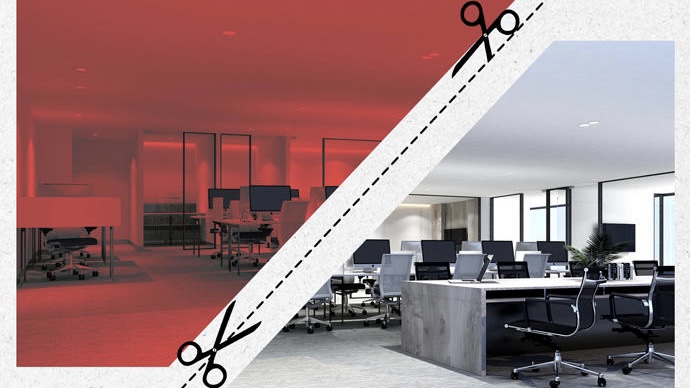Does Hybrid Work Mean Companies Are Downsizing?
Mark DiPietro
Technology Editor
The rippling effects of COVID-19 have touched the lives of everyone across the globe whether that be in healthcare, supply chain shortages, government restrictions, or the seemingly unending list of reverberations attributed to the global pandemic. In whichever life sector you look in, the pandemic has forced a paradigm shift in many ways of life. Principal among these is the nature in which we work.
Almost every profession was forced into remote work at some point during the past 3 years, sparking an appetite for hybrid workplaces in the white-collar American workforce. While the research regarding the productivity of in-office vs remote work is still hotly contested, the white-hot labor market is making it undeniable that the majority of workplaces will be forced to offer some form of remote work.
But the way companies address this move concerning office real estate has differed. Some employers have already taken steps to downsize and modernize their offices. Consulting firm Korn Ferry, internet review site Yelp, and government contractor Leidos Holdings all made news over the summer for their moves towards downsizing.
But perhaps no company has taken larger steps towards downsizing than the New York division of the big four accounting firm, KPMG. The Dutch founded company announced in late August that they were cutting their physical office space by over 50%. They plan to vacate their near 800,000 square foot office space spread across three midtown Manhattan locations in favor of a consolidated 456,000 square foot lease in a soon-to-be completed skyscraper in Hudson Yards.

The new space, at address Two Manhattan West, is a state-of-the-art, 56 floor office space that allows for many amenities demanded by the modern workforce. The architecture provides a mostly open floor plan with modern workstations, natural lighting, and green space areas throughout. KPMG says that they will be trying a three-a-week hybrid work week in which employees are allowed to select which days to be remote. For those who are coming in, the firm will be employing the rent-a-desk method for the majority of employees, which involves the reservation of specific office spaces based on what day each employee will want to go into the office. The move is planning to take place by 2025.
While this news seems like an indication of things to come, statistics suggest that the majority of companies are not ready to take as extreme of a step. Analysts at the Harvard Business Review claim that though these changes to work schedules seem to be here to stay, companies cannot just flee their physical locations. They explain that despite the changes, the cut to office space nationally has only been between 1% to 2%. This is because although the KPMG blueprint seems to be a useful way to blend remote and in-person work, there are some fundamental challenges.
For example, employees overwhelmingly choose Mondays and Fridays when faced with the choice of which days to be remote. Therefore, if specific schedules are not outlined then the company has to contend with days in which an influx of employees come into the office. Therefore, if the office space has been underestimated then that might lead to crowded office space, something that is still to be very much avoided for pandemic and non-pandemic reasons. A solution to this may be a schedule of days to come in. However, with labor markets so tight employers might see great risk in restricting employees in this way.
Companies also face modernization issues. While Two Manhattan West seems is being constructed to accommodate the future workforce, most office buildings are not. So sometimes it is cheaper and easier to renovate current buildings versus move to newly constructed ones. There also is other barriers to this change like lease lengths and costs to move that some companies do not have, especially in an inflation squeezed economy.
As students and young professionals look to enter the workforce, the logistical challenge of managing a hybrid workforce will boost some companies to the top of the market for new talent. Whether this trend towards downsizing will continue or not remains to be seen. But the ramifications of the shifting landscape will have to be grappled with by every workplace.
Contact Mark at mark.dipietro@student.shu.edu

